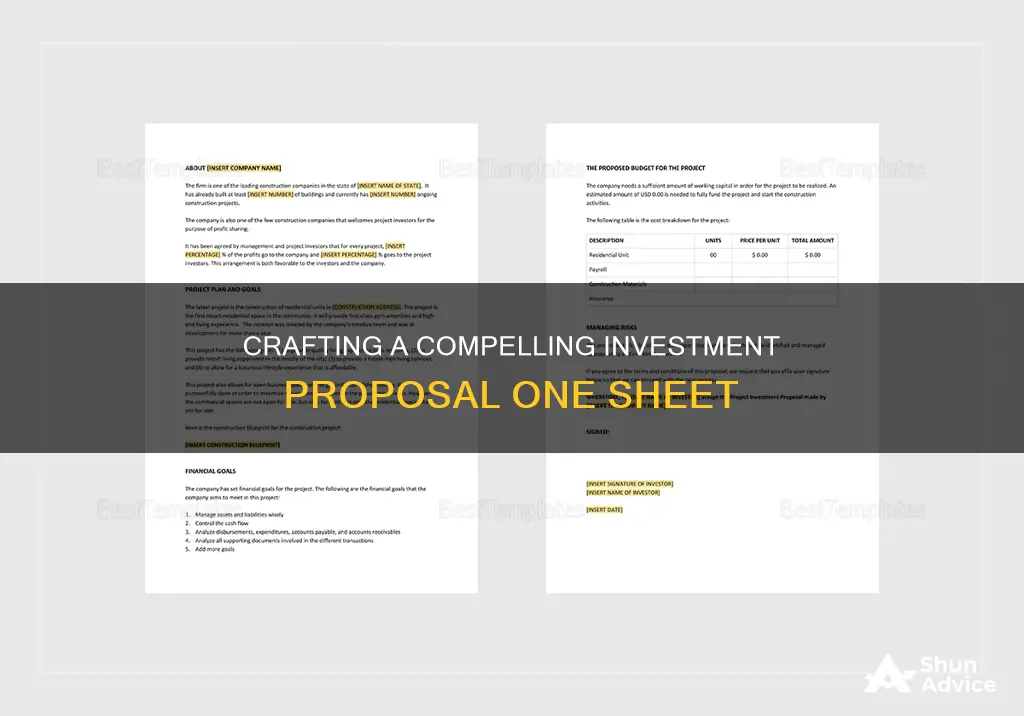
An investment proposal is a document or presentation that outlines a potential investment opportunity, aiming to persuade investors to allocate funds to a specific project, venture, or asset. It is a crucial tool for startups to showcase their value, market potential, and financial viability to secure funding. The proposal should include an executive summary, business overview, product/service overview, market analysis, investment opportunity, business model, marketing and sales strategies, financial projections, risk analysis, and team introduction. It should be concise, focused on financial details, and tailored to the investor.
| Characteristics | Values |
|---|---|
| Executive Summary | Short, attention-grabbing summary with important and enticing details |
| Business Overview | Snapshot of the company's mission, vision, goals, and unique qualities |
| Market Analysis | Overview of industry trends, market size, and competitive landscape |
| Investment Opportunity | Amount of funding needed, how it will be used, and expected returns for investors |
| Business Model and Strategy | Explanation of how the business makes money and its growth roadmap |
| Marketing and Sales Strategies | Specific strategies for reaching and converting customers |
| Financial Projections | Realistic picture of the business's financial future, including revenue forecasts and profit margins |
| Risk Analysis | Addressing potential challenges and outlining strategies to manage or mitigate risks |
| Team Introduction | Highlighting the skills and experience of the team, showcasing their ability to execute the venture successfully |
What You'll Learn
- Executive Summary: A concise, attention-grabbing summary that highlights the business's unique value proposition and financial projections
- Business Overview: Snapshot of the company's mission, vision, goals, and what sets it apart from competitors
- Market Analysis: Demonstrate understanding of the industry, market size, trends, competitive landscape, and opportunities
- Investment Opportunity: Clearly outline the investment amount, how it will be used, and the expected return on investment
- Financial Projections: Provide realistic and detailed revenue forecasts, profit margins, and break-even analysis

Executive Summary: A concise, attention-grabbing summary that highlights the business's unique value proposition and financial projections
Executive Summary
[Insert Company Name]
In a world where [describe the problem your company is trying to solve], [Company Name] is a [company type] that [describe what your company does to solve the problem]. Our mission is to [insert mission statement]. We are seeking [amount of funding] in funding to [reason for funding].
Our company is unique because [reasons your company is unique]. Our team is made up of [names and roles of key team members], who bring [skills and experience of team members].
Our financial projections are as follows:
- [Detail 1 of financial projections]
- [Detail 2 of financial projections]
- [Detail 3 of financial projections]
We believe that this investment opportunity is worth your while because [reasons why the investment is a good opportunity]. We invite you to be a part of our journey and help us make a difference in the world.
Savvy Savings: Guide to Smart Investments and Reddit Tips
You may want to see also

Business Overview: Snapshot of the company's mission, vision, goals, and what sets it apart from competitors
A business overview is a crucial element of an investment proposal, providing a snapshot of the company's mission, vision, goals, and unique characteristics that set it apart from its competitors. This section is essential for laying the groundwork and giving investors a clear understanding of the company's purpose and direction. Here is a detailed outline for the "Business Overview" section of your investment proposal:
Mission and Vision:
Start by articulating the company's mission statement—a concise and powerful description of the company's overarching purpose, the problem it aims to solve, and the value it aims to bring to the market. This statement should be inspiring and provide a glimpse into the company's long-term aspirations.
Company Goals:
Clearly define the short-term and long-term goals of the company. Are there specific milestones or targets the company aims to achieve? What key performance indicators (KPIs) will be used to measure success? Outline the strategic objectives that will guide the company's journey and help it stay focused and aligned.
Unique Selling Proposition (USP):
What sets this company apart from its competitors? Identify the company's unique selling points and highlight why its products or services stand out in the market. Discuss any innovative features, exceptional quality, or pricing strategies that give the company an edge over its rivals.
Target Market and Customer Demographics:
Provide a detailed analysis of the company's target market and the specific customer segments it aims to reach. Include demographic information such as age, gender, income levels, preferences, and any other relevant psychographic data. Understanding the target audience is crucial for investors to grasp the company's market positioning and growth potential.
Competitive Analysis:
Conduct a thorough analysis of the company's competitors. Identify their strengths and weaknesses and explain how the company plans to differentiate itself and gain a competitive edge. Are there any unique strategies or approaches the company intends to employ to stay ahead of the competition? This section demonstrates the company's ability to navigate the market effectively.
Remember to keep the "Business Overview" section concise and focused. Provide a clear and compelling snapshot that showcases the company's unique attributes and growth potential. This section should leave investors with a strong understanding of the company's mission, vision, goals, and market positioning, ultimately building their confidence in the investment opportunity.
Devising an Investment Portfolio: Strategies for Success
You may want to see also

Market Analysis: Demonstrate understanding of the industry, market size, trends, competitive landscape, and opportunities
Market analysis is a crucial aspect of any investment proposal, offering a holistic view of the market's dynamics, trends, and competitive landscape. Here are some detailed paragraphs on each aspect of market analysis to include in your one-sheet investment proposal:
Industry Understanding:
Understanding the industry is essential to grasp the context in which your investment opportunity exists. This involves researching and analyzing the specific sector or sectors relevant to your proposal. Identify the key players, trends, and dynamics shaping the industry. For example, if you are proposing an investment in the healthcare sector, understand the regulatory environment, emerging technologies, and consumer trends within that industry. This demonstrates a nuanced grasp of the industry and its unique characteristics.
Market Size and Growth Potential:
Providing insights into the market size and its potential for growth is critical. Include data and projections on the current market size, historical growth rates, and future expectations. For instance, if you are proposing an investment in a tech startup, showcase the market size of the specific niche they operate in and highlight the potential for expansion. This showcases the scalability and revenue potential of the investment opportunity.
Trend Analysis:
Staying ahead of market trends is vital for making informed investment decisions. Identify key shifts in consumer behavior and preferences to spot emerging trends before they peak. For example, if you are proposing an investment in a consumer goods company, analyze trends in consumer spending, product preferences, and emerging niches. This demonstrates a forward-thinking approach and helps investors anticipate future movements in the market.
Competitive Landscape:
Understanding the competitive landscape is crucial for highlighting the strengths and weaknesses of the investment opportunity. Identify the direct and indirect competitors within the industry. Assess their market positioning, strategies, and unique selling points. By doing so, you can showcase how the investment opportunity differs from or improves upon existing offerings. For instance, if you are proposing an investment in a new social media platform, analyze the features, pricing models, and user engagement strategies of existing platforms to demonstrate how your proposal stacks up.
Opportunities and Threats:
Finally, it is essential to identify the opportunities and potential threats associated with the investment. This involves analyzing the market, industry, and competitive trends to uncover untapped areas for growth and potential challenges. For example, if you are proposing an investment in renewable energy, identify emerging technologies, regulatory changes, or consumer trends that could impact the success of the venture. This demonstrates a proactive approach to investment and helps mitigate potential risks.
Investment Management Fees: California's Deductible Expenses Explained
You may want to see also

Investment Opportunity: Clearly outline the investment amount, how it will be used, and the expected return on investment
Investment Opportunity
Investment Amount
The amount of funding required for this investment opportunity is [insert amount]. This figure has been calculated based on thorough financial projections and takes into account various factors, including [insert factors that have influenced the amount]. We believe that this investment amount will enable us to achieve our goals and maximize the potential of this opportunity.
How the Investment will be Used
The investment funds will be allocated across several key areas to support the growth and success of the business. Here is a breakdown of how the funds will be utilized:
[Insert allocation of funds e.g. product development, marketing and sales, operational expenses, etc.]
By allocating the funds in this manner, we will be able to effectively execute our business strategy and achieve our short-term and long-term objectives.
Expected Return on Investment
We are confident that this investment opportunity offers a highly attractive return on investment for potential investors. Our financial projections indicate that the investment is expected to generate a return of [insert expected ROI percentage] over a period of [insert time frame]. This projection is based on comprehensive market research, competitive analysis, and our understanding of industry trends. We believe that our unique value proposition, experienced team, and scalable business model will contribute to achieving this expected return.
To further enhance the potential return on investment, we have developed a clear exit strategy that will be implemented at the appropriate time. The exit strategy includes [insert details of exit strategy e.g. initial public offering, acquisition, merger, etc.]. By providing a clear path to liquidity, we aim to reassure investors and demonstrate our commitment to delivering tangible outcomes.
Traveling Far for Investment Purchases: How Far is Too Far?
You may want to see also

Financial Projections: Provide realistic and detailed revenue forecasts, profit margins, and break-even analysis
A crucial part of an investment proposal is providing financial projections that offer a clear and realistic overview of the business's financial health and prospects. This includes detailed forecasts for revenue, profit margins, and break-even analysis, all of which are essential for potential investors to understand the business's viability and potential for success.
Revenue Forecasts
Revenue forecasts are predictions of the business's anticipated monthly or yearly revenues. To create accurate forecasts, it is important to conduct a careful study of the business's potential market. It is normal for some of these numbers to be rough estimates, especially for startups, as sales can be challenging to predict. However, by researching industry spending and using sales data, more accurate revenue projections can be made. These forecasts are crucial for investors as they indicate the business's ability to repay loans and generate profits.
Profit Margin Analysis
Before calculating profit margins, it is essential to establish all the costs associated with the business, including both fixed and variable costs. Fixed costs remain constant regardless of sales volume, such as rent, salaries, and insurance. Variable costs, on the other hand, fluctuate with sales volume, such as labour costs, sales commissions, and shipping expenses. By understanding these costs, investors can evaluate the business's ability to generate profits.
Break-Even Analysis
Break-even analysis is a financial calculation that determines the point at which a business's revenue covers all its costs, meaning it has neither gained nor lost money. This analysis weighs the costs of the business against the unit selling price. It is an important tool for risk assessment, helping investors understand when their investment will be returned and if the endeavour is worth pursuing. Additionally, it assists in considering price and cost adjustments and determining if additional funding is required.
Putting It All Together
Financial projections are a critical aspect of an investment proposal as they provide investors with a comprehensive understanding of the business's financial health and growth potential. By offering revenue forecasts, profit margin targets, and break-even analysis, investors can assess the business's viability, profitability, and ability to manage finances effectively. These projections are essential for securing funding and building trust with investors.
Effective Yield: Understanding Your Investment Portfolio's Performance
You may want to see also
Frequently asked questions
A successful investment proposal should include the following:
- Introduction (UVP + hook): Start with a compelling introduction that presents your Unique Value Proposition (UVP) and an engaging hook that captures the essence of your business.
- Problem and Solution: Clearly define the specific problem or need in your market that your business addresses, and describe your unique solution.
- Market Analysis: Provide an overview of the market size, trends, and competitive landscape. Identify market gaps and demonstrate your understanding of the industry and target audience.
- Business and Revenue Model: Explain how your business will generate revenue, including revenue streams and business model.
- Traction and Validation: Showcase any traction or validation your business has received, such as customer feedback, sales figures, awards, or testimonials.
- Marketing and Growth Strategy: Outline your strategy for acquiring and retaining customers, and how you plan to scale your business.
- Team: Highlight the strengths and expertise of your team, and explain how they contribute to the success of your business.
- Financials: Provide a clear and realistic financial plan, including past and projected revenue, expenses, and profitability.
- Investment and Use of Funds: Specify the amount of investment you are seeking and provide a detailed breakdown of how you plan to utilise the funds to grow your business.
Here are some key considerations and best practices to enhance your investment proposal:
- Know Your Audience: Tailor your proposal to resonate with the interests and investment philosophy of your target investors.
- Balance Emotional and Logical Appeals: In addition to logical arguments, incorporate storytelling and emotional elements to make your proposal more compelling and memorable.
- Conduct Thorough Research: Ensure you have accurate and up-to-date information about the market, competitors, customer demands, and your target investors.
- Provide Clear Financial Projections: Offer detailed and realistic financial projections, including revenue forecasts, profit margins, and break-even analysis.
- Address Risks and Challenges: Be transparent about potential challenges and risks, and outline your strategies for managing or mitigating them.
- Focus on Benefits: Instead of solely focusing on features, highlight how your product or service will improve lives, save time, or reduce costs for your customers.
- Showcase Early Product Prototypes: If possible, include prototypes, wireframes, or design visuals to give investors a tangible sense of your product or service.
- Provide a Strong Executive Summary: Craft a concise and engaging executive summary that captures the essence of your business idea, market opportunity, unique value proposition, and investment sought.
Here are some things to avoid when crafting your investment proposal:
- Unsubstantiated Claims: Avoid making statements or using data that you cannot back up with research or evidence.
- Jargon and Complex Terminology: Use simple and clear language to ensure your proposal is accessible and understandable to a broad audience.
- Unrealistic Projections: Be honest and transparent in your financial projections and address potential challenges. Avoid painting an overly optimistic picture.
- Irrelevant Information: Stay focused on the key points and avoid including unnecessary or irrelevant details that may distract from your main message.
- Excessive Length: Respect the time of your investors by keeping your proposal concise and to the point. Aim for brevity without sacrificing essential details.







